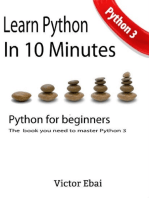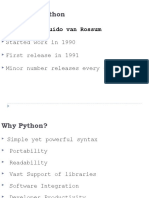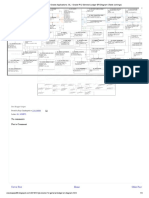1. Introduction to Python
Uploaded by
techyboost011. Introduction to Python
Uploaded by
techyboost01INTRODUTION TO PYTHON
1.1 Introduction:
General-purpose Object Oriented Programming language.
High-level language
Developed in late 1980 by Guido van Rossum at National Research Institute for
Mathematics and Computer Science in the Netherlands.
It is derived from programming languages such as ABC, Modula 3, small talk, Algol-
68.
It is Open Source Scripting language.
It is Case-sensitive language (Difference between uppercase and lowercase letters).
One of the official languages at Google.
1.2 Characteristics of Python:
Interpreted: Python source code is compiled to byte code as a .pyc file, and this byte
code can be interpreted by the interpreter.
Interactive
Object Oriented Programming Language
Easy & Simple
Portable
Scalable: Provides improved structure for supporting large programs.
Integrated
Expressive Language
1.3 Python Interpreter:
Names of some Python interpreters are:
PyCharm
Python IDLE
The Python Bundle
pyGUI
Sublime Text etc.
There are two modes to use the python interpreter:
i. Interactive Mode
ii. Script Mode
i. Interactive Mode: Without passing python script file to the interpreter, directly
execute code to Python (Command line).
Example:
>>>6+3
Output: 9
Fig: Interactive Mode
Note: >>> is a command the python interpreter uses to indicate that it is ready. The
interactive mode is better when a programmer deals with small pieces of code.
To run a python file on command line:
C:\Python33\python programs\
ii. Script Mode: In this mode source code is stored in a file with the .py extension
and use the interpreter to execute the contents of the file. To execute the script by the
interpreter, you have to tell the interpreter the name of the file.
Example:
if you have a file name Demo.py , to run the script you have to follow the following
steps:
Step-1: Open the text editor i.e. Notepad
Step-2: Write the python code and save the file with .py file extension. (Default
directory is C:\Python33/Demo.py)
Step-3: Open IDLE ( Python GUI) python shell
Step-4: Click on file menu and select the open option
Step-5: Select the existing python file
Step-6: Now a window of python file will be opened
Step-7: Click on Run menu and the option Run Module.
Step-8: Output will be displayed on python shell window.
Fig. : IDLE (Python GUI)
Fig: Python Shell
You might also like
- Python Learn Python in 24 Hours Robert Dwigh100% (3)Python Learn Python in 24 Hours Robert Dwigh168 pages
- Padhaaii: Chapter-1 Introdution To PythonNo ratings yetPadhaaii: Chapter-1 Introdution To Python3 pages
- Application Based Programming in Python Chapter 1No ratings yetApplication Based Programming in Python Chapter 116 pages
- Chapter-5 XIC CS Python Introduction (1)No ratings yetChapter-5 XIC CS Python Introduction (1)78 pages
- Material_23b91aa5-0c0c-4108-bf30-a3240454797bNo ratings yetMaterial_23b91aa5-0c0c-4108-bf30-a3240454797b26 pages
- Module 1 Introduction To Algorithms and Python Programming BasicsNo ratings yetModule 1 Introduction To Algorithms and Python Programming Basics34 pages
- Python Programming BCC 302 Unit 1 NotesNo ratings yetPython Programming BCC 302 Unit 1 Notes22 pages
- APznzaaycw TsI Ksr UwvtYb807ayuqjlZ GCFtH1XSONvBngW6DrKGe3yLLsqDGd9o 8U9OMe COF C490y 44dtOBH 53h6NwHltR5OAZgVNns8UNp TmCr OewKKX0UsOCenzeYWn0SpjKC1P8Nz8asTUl8tCw1bcW2PeV2IKl9qsdeWTf59tasEvTORq2ziWW s4diMGGVVYPu rNo ratings yetAPznzaaycw TsI Ksr UwvtYb807ayuqjlZ GCFtH1XSONvBngW6DrKGe3yLLsqDGd9o 8U9OMe COF C490y 44dtOBH 53h6NwHltR5OAZgVNns8UNp TmCr OewKKX0UsOCenzeYWn0SpjKC1P8Nz8asTUl8tCw1bcW2PeV2IKl9qsdeWTf59tasEvTORq2ziWW s4diMGGVVYPu r39 pages
- Programming and Problem Solving With PythonNo ratings yetProgramming and Problem Solving With Python13 pages
- EXAMPLE Entry Level Data Scientist ResumeNo ratings yetEXAMPLE Entry Level Data Scientist Resume1 page
- A Marketing Analytics Framework For CMOsNo ratings yetA Marketing Analytics Framework For CMOs6 pages
- A Study On The Expenditure of The Adamson University Students On Mobile Prepaid LoadNo ratings yetA Study On The Expenditure of The Adamson University Students On Mobile Prepaid Load1 page
- Enhancing Security and Scalability Through Expert Cloud ConsultingNo ratings yetEnhancing Security and Scalability Through Expert Cloud Consulting8 pages
- Oracle Applications - GL - Oracle R12 General Ledger ER Diagram (Table Joinings)No ratings yetOracle Applications - GL - Oracle R12 General Ledger ER Diagram (Table Joinings)3 pages
- ITIL Strategy Design Transition Operation ProcessNo ratings yetITIL Strategy Design Transition Operation Process32 pages
- Information Security Policy For Ronzag: December 2019100% (1)Information Security Policy For Ronzag: December 201926 pages
- Udacity Enterprise Syllabus Digital Marketing Nd018No ratings yetUdacity Enterprise Syllabus Digital Marketing Nd01818 pages
- Smart India Hackathon Real Time Monitoring and Evaluation Software for Fire DepartmentNo ratings yetSmart India Hackathon Real Time Monitoring and Evaluation Software for Fire Department10 pages

























































































